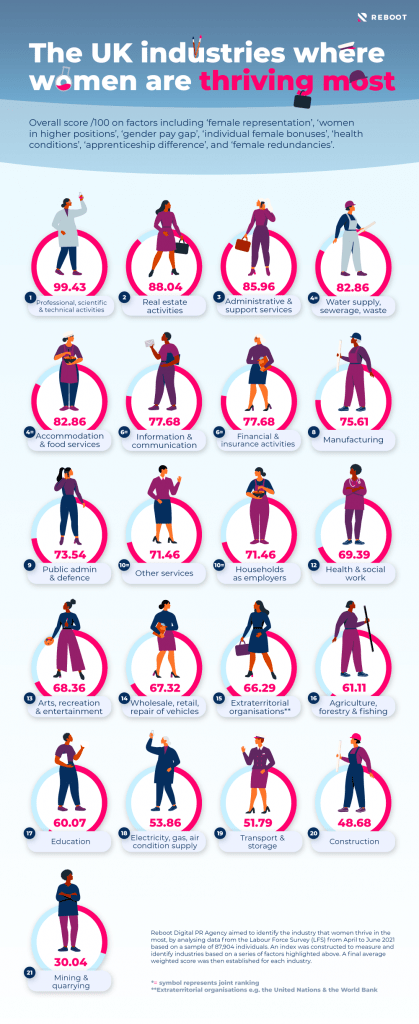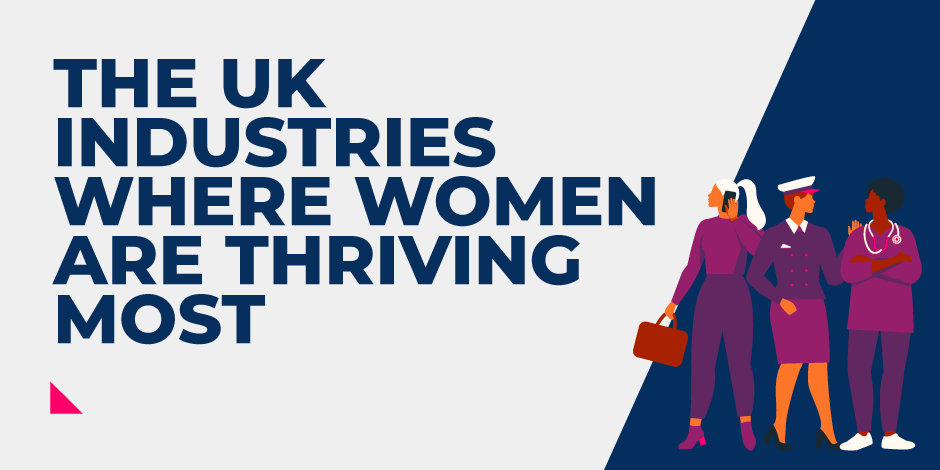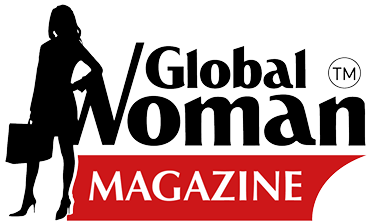
Women at Work: The UK Industries Where Women Are Thriving the Most
There’s no denying that women continue to face barriers to progression in the UK workforce. Looking ahead, CEO and co-founder of Reboot, Naomi Aharony shares that ‘introducing better benefits and flexibility will enable women at work to experience less burnout, increase motivation and progression, encouraging not only a better working environment but also an exploration of other unexpected career paths.’
However, the last decade has seen more women moving into traditionally male-dominated industries, as well as a rise in female entrepreneurs. As of 2021, 72.1% of women are employed, a percentage that has risen from 52.8% in 1971.
Although the representation of women in the UK is steadily increasing, which industries are seeing the most success when it comes to narrowing the gender gap?
Reboot data and digital PR specialists sought to find out by analysing data from the Labour Force Survey (LFS) from April to June 2021, based on a sample of 87,904 individuals (who were employed, self-employed or were in a Government scheme at the time of the survey, and were made redundant over the last three months).
An index was constructed to measure and identify significant factors like industries with the highest female representation, the most females in high positions and the lowest gender pay gap. A final average weighted score was then calculated for each industry.
Women’s progress in the workplace has seen a great deal of uncertainty, not least because of the problems of gender equality in various sectors, but problems that the pandemic has also intensified.

Interested in women’s progress in the workplace, Reboot Digital PR Agency sought to determine which UK industry women are thriving in the most by evaluating the factors of female representation, women in higher positions, gender pay gap, individual female bonuses, health conditions, apprenticeship differences, and female redundancies.
Reboot Digital Agency can now reveal that professional, scientific and technical activities is the industry where women in the UK are thriving the most with an overall index score of 99.43 out of 100. Whilst the sector sees one of the widest pay gaps (women are paid 27.96% less), female representation of 44.63% and 72.17% of women without health problems contribute to this final high score.
Following in second place are real estate activities with an overall score of 88.04/100. The real estate industry in the UK has 49.27% female representation and the highest percentage of females in higher positions of leadership (13.45%).
The administrative and support services secure an overall score of 85.96/100, placing third. This industry records 44.46% female representation, where female employees are being paid 1.85% more than men.
In fourth place is the water supply, sewerage and waste industry with an overall score of 82.86/100. Despite seeing a relatively lower female representation of 23.40%, women in this industry are being paid 17.13% more than men. It also has the second-highest percentage of women in apprenticeships compared to men (1.74%).
Also in joint fourth is the accommodation and food services (82.86/100). The industry reveals 52.34% female representation and sees 6.81% of females in higher positions of leadership – second in the category.
In last place (30.04/100), women in the mining and quarrying industry are thriving the least – according to the data, women in these roles are being paid 95.14% less than men. Historically known as a male-dominated industry, it also places second to last for female representation (18.61%) after construction (14.65%).
Naomi Aharony, CEO and Co-Founder at Reboot Digital PR Agency has provided some comments on the results of the study and women in the industry:
“Overall, the final ranking is promising in that of all the industries analysed, 15 out of the 21 scored above 65 for women’s opportunities. The gender pay gap across all industries is one amongst many factors that are being tackled in the workplace, so it’s very interesting to see a male-dominated industry like construction paying female employees 4.63% more. Though, there is a lot more to be done in normalising gender equality as well as providing a better environment for women in the workplace.”

Methodology:
- Reboot Digital PR Agency conducted an index study with the aim of identifying the industry that women thrive in the most.
- This study analyses quarterly data from the Labour Force Survey (LFS) from April to June 2021 based on a sample of 87,904 individuals, which studies the employment circumstances of the UK population.
- The sample was filtered by employment status focusing on employees, self-employed, government scheme and unpaid family workers.
- An index was constructed to measure and identify industries with the highest female representation, most females in high positions (managers, directors and senior officials), most female individual bonuses obtained, females with fewest health conditions, lowest gender pay gap, lowest gender gap in number with apprenticeships and lowest female redundancies. The gender pay gap difference has been calculated based on the average gross hourly pay of females and males.
- To ensure the survey samples are representative of the population they describe, population weighting variables (PWT20 and PIWT20 for hour pay) provided by the Office for National Statistics (ONS) and contained within the LFS dataset were used.
- To conclude the research, a final score was established by normalising the data using the average percentrank.inc function and giving an average weighted score for each industry.
- Data was collected on 21st September 2021 and is subject to change.
**The study is based only on people that were employed, self-employed or in Government schemes at the time of the survey and were made redundant in the last 3 months. The variable does not represent the redundancy rate in the UK.





